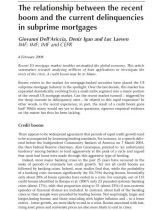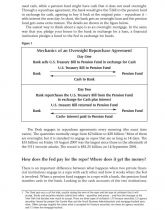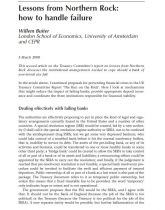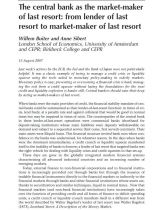Hľadaj
Zobraz:
Univerzity
Kategórie
Rozšírené vyhľadávanie
45 146
projektov
The First Global Financial Crisis of the 21st Century
| Prípona |
Typ analýza |
Stiahnuté 83 x |
| Veľkosť 1,1 MB |
Jazyk anglický |
ID projektu 13214 |
| Posledná úprava 04.11.2020 |
Zobrazené 3 059 x |
Autor: - |
 Zdieľaj na Facebooku
Zdieľaj na Facebooku |
||
| Detaily projektu | ||
- cena:
0 Kreditov - kvalita:
96,6% -
Stiahni
- Pridaj na porovnanie
- Univerzita:Paneurópska vysoká škola
- Fakulta:Fakulta ekonómie a podnikania
- Kategória:Finančníctvo » Financie
- Predmet:Global economics
- Študijný program:-
- Ročník:3. ročník
- Formát:PDF dokument (.pdf)
- Rozsah A4:204 strán
Global financial markets are showing strains on a scale and scope not witnessed in the past three-quarters of a century. What started with elevated losses on US subprime mortgages has spread beyond the borders of the United States and the confines of the mortgage market. Risk spreads have ballooned, liquidity in some market segments has dried up and large complex financial institutions have admitted significant losses. Bank runs are no longer the subject exclusively of history.
These events have challenged policy-makers, and the responses have varied across regions. The ECB has injected reserves in unprecedented volumes. The Bank of England participated in the bailout and, ultimately, the nationalization of a depository, Northern Rock. The US Federal Reserve has introduced a variety of new facilities and extended its support beyond the depository sector.
These events have also challenged economists to explain why the crisis developed, how it is unfolding, and what can be done. This volume compiles contributions by leading economists in VoxEU over the past year that attempt to answer these questions. We have grouped these contributions into three sections corresponding to those three critical questions.
Why did the crisis happen?
The first set of articles contains reflections on the reasons for the crisis. Although it is tempting to suggest that the crisis was inevitable with hindsight, several articles emphasize the inherent uncertainty of economic analysis. Dell’Ariccia, Igan and Laeven discuss the role of uncertainty in the subprime lending boom. Persaud and Danielsson both caution against the overreliance on standardized quantitative risk models. Finally, Wyplosz counsels prudence when analysing the crisis and its causes in the face of high uncertainty.
...
These events have challenged policy-makers, and the responses have varied across regions. The ECB has injected reserves in unprecedented volumes. The Bank of England participated in the bailout and, ultimately, the nationalization of a depository, Northern Rock. The US Federal Reserve has introduced a variety of new facilities and extended its support beyond the depository sector.
These events have also challenged economists to explain why the crisis developed, how it is unfolding, and what can be done. This volume compiles contributions by leading economists in VoxEU over the past year that attempt to answer these questions. We have grouped these contributions into three sections corresponding to those three critical questions.
Why did the crisis happen?
The first set of articles contains reflections on the reasons for the crisis. Although it is tempting to suggest that the crisis was inevitable with hindsight, several articles emphasize the inherent uncertainty of economic analysis. Dell’Ariccia, Igan and Laeven discuss the role of uncertainty in the subprime lending boom. Persaud and Danielsson both caution against the overreliance on standardized quantitative risk models. Finally, Wyplosz counsels prudence when analysing the crisis and its causes in the face of high uncertainty.
...
Kľúčové slová:
crisis
financial
global
financial crisis
global financial crisis
kríza
finančný
finančná
finančná kríza
ekonomika
globálna ekonomika
global econimics
Obsah:
- Preface ix
Introduction 1
Section 1 Why Did the Crisis Happen? 5
The relationship between the recent boom and the current 7
delinquencies in subprime mortgages
Giovanni Dell’Ariccia, Deniz Igan and Luc Laeven
Why bank risk models failed 11
Avinash Persaud
Blame the models 13
Jon Danielsson
The subprime crisis: observations on the emerging debate 17
Charles Wyplosz
The subprime series, part 1: Financial crises are not 21
going away
Stephen G. Cecchetti
The subprime series, part 2: Deposit insurance and the 25
lender of last resort
Stephen G. Cecchetti
The subprime series, part 3: Why central banks should be 29
financial supervisors
Stephen G. Cecchetti
The subprime series, part 4: Does well-designed monetary 33
policy encourage risk- taking?
Stephen G. Cecchetti
The subprime crisis: Greenspan’s Legacy 37
Tito Boeri and Luigi Guiso
The impact of short-term interest rates on risk-taking: 41
hard evidence
Vasso P. Ioannidou, Steven Ongena and Jose Luis Peydró
Why did bank supervision fail? 45
Guido Tabellini
...
Section 3 What Can Be Done? 119
The subprime crisis: Who pays and what needs fixing 121
Marco Onado
Filling the information gap 125
Alberto Giovannini and Luigi Spaventa
Lessons from the North Atlantic financial crisis 129
Willem Buiter
Lessons from Northern Rock: banking and shadow 133
banking
Willem Buiter
Lessons from Northern Rock: how to handle failure 137
Willem Buiter
Ratings agency reform 145
Richard Portes
How to avoid further credit and liquidity confidence crises 151
Guillermo de la Dehesa
The inappropriateness of financial regulation 155
Avinash Persaud
There is more to central banking than inflation targeting 159
Paul De Grauwe
Can monetary policy really be used to stabilize asset prices? 163
Katrin Assenmacher-Wesche and Stefan Gerlach
A missed opportunity for the Fed 167
Willem Buiter and Anne Sibert
The central bank as the market-maker of last resort: 171
from lender of last resort to market-maker of last resort
Willem Buiter and Anne Sibert
Avoiding disorderly deleveraging 179
Luigi Spaventa
Chronology 183
Glossary 191
Zdroje:
- Centre for Economic Policy Research: The First Global Financial Crisis of the 21st Century, A VoxEU.org Publication, ISBN: 978-0-9557009-3-4








